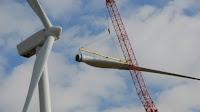 Experts estimate that the wind blowing across the planet holds enough energy to meet all human needs 100 times over. The question then is how to capture it. There are some interesting new approaches being developed.
Experts estimate that the wind blowing across the planet holds enough energy to meet all human needs 100 times over. The question then is how to capture it. There are some interesting new approaches being developed.Alternative Energy News.Info reports.
"The Kite Wind Generator simply known as KiteGen is an Italian company. They are installing kites that sprout from funnel like structures. They are mounted on giant poles. When wind blows these kites come out of funnels. For short, use kites that spring from funnels on the end of giant poles when the wind blows. For each kite, winches release a pair of high-resistance cables to control direction and angle. These kites are light and ultra-resistant. These kites are similar to those used for kite surfing - light and ultra-resistant, capable of flying up to a height of 2,000 meters.
The basics of the wind turbines and KiteGen are same. But they have moved the heaviest parts to the ground. They claim that the resulting structure, base foundation included, is much lighter and cheaper. They have also provided flexibility regarding the height of kites. If the wind is strong at certain height, the height of the kite too can be adjusted accordingly. If today wind if blowing nicely at 1000m, say, kites can be adjusted at the same height. If tomorrow the strong wind is blowing at certain other height, wind kites can be flown at that height to gain maximum advantage of the wind power." See full article and video.

 Mexican car builders are showing interest in a dramatic new taxi design.
Mexican car builders are showing interest in a dramatic new taxi design.

 A form of alternative energy that shows great promise involves the ocean and the use of osmosis.
A form of alternative energy that shows great promise involves the ocean and the use of osmosis.











